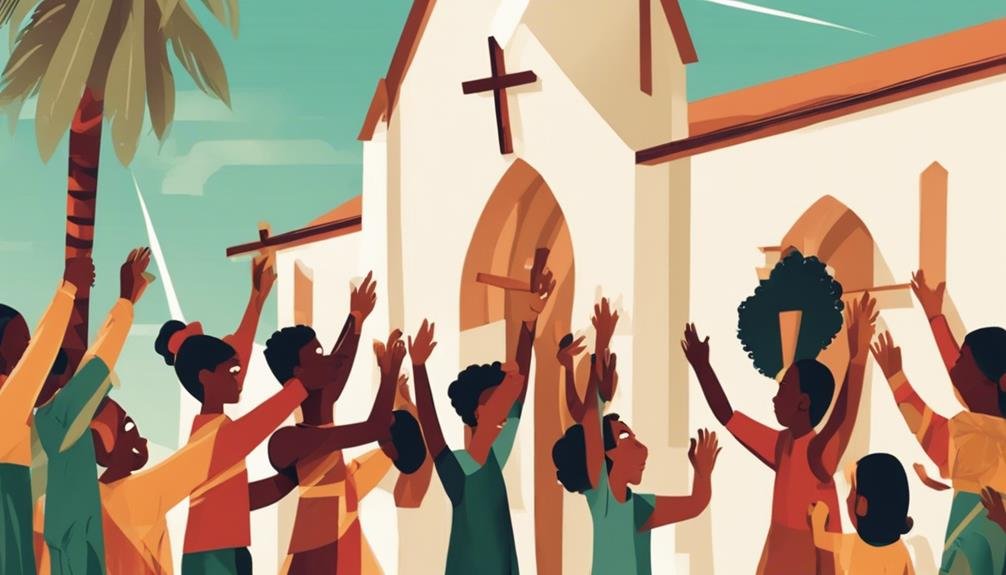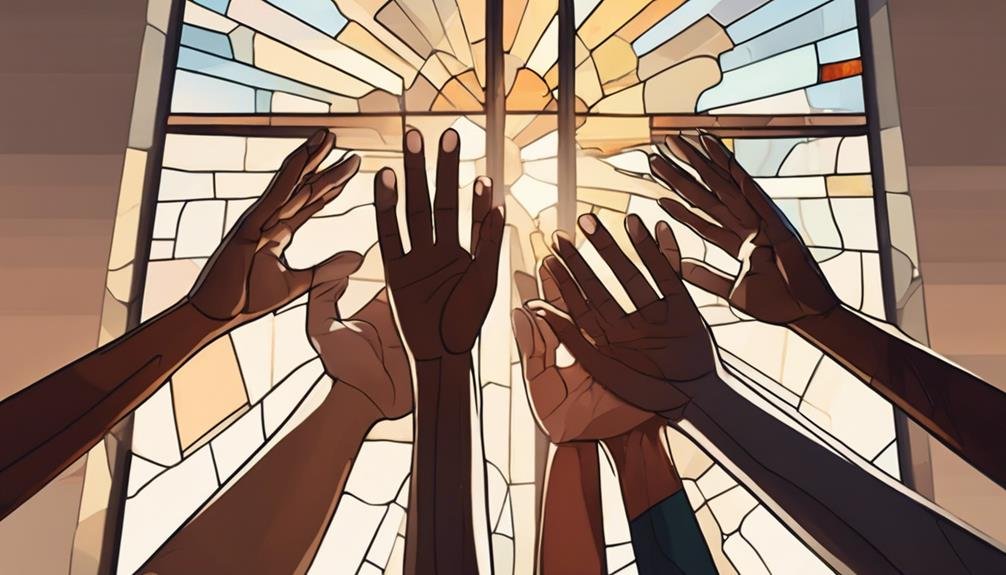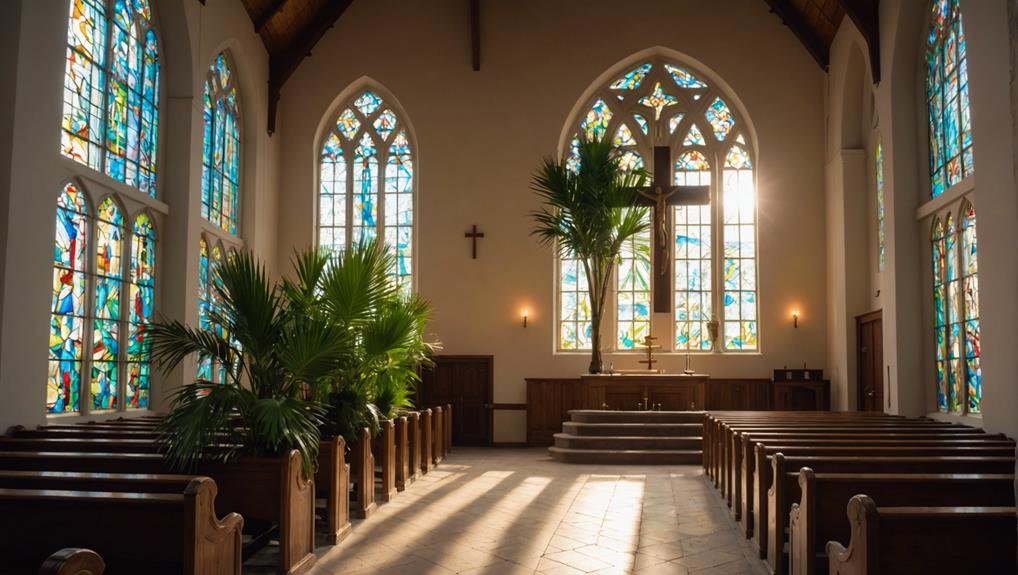You might wonder why palms are so prevalent in Palms Significant in Christian, especially during Palm Sunday services. Historically, palms were used to celebrate Jesus’ entry into Jerusalem, symbolizing victory and peace. This tradition not only commemorates a pivotal moment in Christian scripture but also weaves a thread between ancient Jewish customs and modern Christian practices. However, the significance of palms extends beyond mere historical events. They embody deeper theological implications about triumph over adversity—a theme that resonates just as powerfully today. What might this mean for contemporary worship, and how does this ancient symbol influence modern faith communities?
Key Takeaways
- Palms are used to commemorate Jesus’ Triumphal Entry into Jerusalem, symbolizing his recognition as the Messiah.
- They represent victory and triumph, echoing Jesus’ ultimate victory over sin and death.
- Palm Sunday, marked by waving palm branches, initiates Holy Week, a pivotal period in Christian tradition.
- The use of palms ties Christian practices to ancient Jewish customs, particularly the Feast of Tabernacles.
- Palms in worship underscore core Christian victories and deepen the spiritual experience of recognizing Jesus as the Savior.
Biblical Roots of Palm Usage
In the Bible, palm branches were first used to honor Jesus during His triumphant entry into Jerusalem. Marking a significant moment of recognition and victory. As you explore the roots of this tradition. It’s important to understand how deeply embedded these symbols are in Christian worship. During the event, known as the Triumphal Entry, which occurs during Holy Week. The crowd spread palm branches on the road and waved them, chanting ‘Hosanna!’ This gesture wasn’t merely decorative. It was steeped in cultural significance. Symbolizing the acknowledgment of Jesus as the Messiah.
The use of palms in this scenario wasn’t random. For the people of Jerusalem, palms were a powerful emblem of triumph and victory, elements that are central to the celebration of Jesus’ arrival. This historical moment isn’t only a narrative of joy and celebration but also forms a pivotal part of Christian liturgy. Today, palms continue to hold a ceremonial place in services, particularly on Palm Sunday, reminding you of Jesus’ victorious entry into Jerusalem. This tradition enriches the tapestry of Christian worship, bridging past with present, and deepening the communal and symbolic celebration of faith.
Symbolism of Victory and Triumph
Palm branches, explored by the crowds during Jesus’ entry into Jerusalem, are powerful symbols of victory and triumph in Christian worship. As you investigate the Gospels, you’ll find that this Triumphal Entry marks a pivotal moment. The people of Jerusalem spread palm branches in Jesus’ path, shouting ‘Hosanna,’ which signifies ‘save, we pray‘. This act wasn’t just a spontaneous gesture but steeped in cultural significance. Historically, palm branches were symbols of victory and peace, used by the Jews to express their recognition of Jesus as the victorious messiah.
In Christian tradition, these palm branches have transcended their ancient origins to symbolize the ultimate victory that Jesus achieves over sin and death. Every Palm Sunday, this imagery renews the message of hope and triumph within the Christian faith. It’s a profound reminder that, through Jesus, believers are offered peace and eternal life, encapsulating the very essence of victory in the Christian narrative.
Understanding this symbolism enriches your perspective on why palms aren’t merely decorative but deeply emblematic of the core victories in Christian theology and worship.
Palm Sunday Celebrations

Every year, Christians around the world celebrate Palm Sunday by participating in processions and waving palm branches to commemorate Jesus’ victorious entry into Jerusalem. This event, known as the Triumphal Entry, marked the beginning of Holy Week and set the tone for the events leading up to Easter Sunday. As you wave your palm branches this Palm Sunday, you’re not just part of a tradition; you’re declaring peace and victory, echoing the ancient cries of “Hosanna!” that greeted Jesus.
Christian churches host these celebrations to honor the symbolic importance of palms, recognizing Jesus as the promised King of Peace. The atmosphere in Jerusalem during that first Palm Sunday was charged with anticipation and joy, which is mirrored in today’s celebrations. Here’s a quick guide to help you get the most out of Palm Sunday:
| Activity | Significance |
|---|---|
| Processions | Emulate Jesus’ entry into Jerusalem |
| Waving Palm Branches | Symbolize victory and peace |
| Church Services | Reflect on the beginning of Holy Week |
Connection to Jewish Traditions
Did you know that the use of palm branches in Christian worship traces back to ancient Jewish traditions? These branches aren’t just decor; they’re steeped in deep historical and cultural significance. In Jewish customs, palm branches were pivotal during the Feast of Tabernacles, a celebration of God’s victory and provision. This powerful symbol transcended into Christian practices, especially evident during Palm Sunday celebrations.
When you see palm branches in Christian settings, you’re witnessing a centuries-old connection to Jewish traditions. This continuity isn’t merely about using similar symbols; it represents the profound bond between the Christian and Jewish faiths. The palms symbolize victory—originally, God’s triumph in Jewish stories, and later, the victory of Jesus, which is central to Christian belief.
This usage highlights how intertwined these traditions are. The cultural and historical significance of palm branches enriches Christian worship. Offering a layer of depth that connects believers to their spiritual ancestors. This connection through palms serves as a bridge between past and present, between Jewish heritage and Christian practice. Making the palms you see in church more than just foliage. They’re a reflection of enduring faith and shared spiritual victories.
What is the significance of palms in Christian worship and why are they important symbols?
The use of palms in Christian worship holds great significance. They are often used on Palm Sunday to symbolize Christ’s triumphal entry into Jerusalem. Palms are considered as the best symbols of victory, peace, and eternal life, making them important elements in Christian traditions and rituals.
Modern Implications in Worship

In modern Christian worship, waving palm branches during Palm Sunday services powerfully symbolizes the recognition of Jesus as the King of Kings and the Messiah. This act is a vivid reminder of the Triumphal Entry into Jerusalem. An event that marks the beginning of Holy Week. As you hold those palm branches high, you’re not just part of a ritual. You’re echoing the shouts of “Hosanna!” from centuries ago, acknowledging Jesus’ victory and his role as the Messiah.
Here’s how this tradition impacts various aspects of contemporary Christian worship:
| Aspect | Significance | Connection to Holy Week |
|---|---|---|
| Visuals | Creates a vivid scene | Reminds of Jesus’ entry |
| Participation | Engages congregation | Reflects crowd from Jesus’ time |
| Spiritual Meaning | Emphasizes Jesus as Savior | Deepens the Holy Week experience |
This tradition isn’t just about remembering a historical event. It’s about making the story of Jesus’ sacrifice and victory a tangible part of your faith today. Each palm branch waved is a personal declaration, a symbol of peace and salvation that transcends time. Connecting you directly to the heart of Christian worship.
Conclusion
In your worship, palms aren’t just foliage; they’re powerful symbols rooted in biblical history. They mark Jesus’ victorious entry into Jerusalem, celebrated on Palm Sunday, and echo ancient Jewish victories. These traditions connect deeply with your faith and highlight a shared heritage.
Today, when you wave palm branches, you’re not only remembering Christ’s triumph but also reinforcing your commitment to overcoming spiritual battles. Palms encapsulate victory, heritage, and ongoing spiritual commitment in your worship practices.

